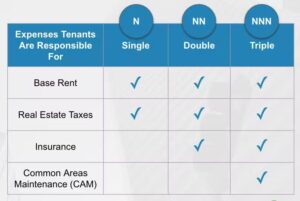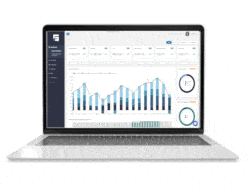Understanding pro-rata share is crucial when investing in commercial real estate, as many leases use this term. Pro-rata refers to a method of distributing expenses among tenants in a specific building. The pro-rata share shows how much each tenant pays for shared costs. These costs include maintenance fees, utilities, and property taxes. Each tenant’s share depends on the size of their leased space compared to the total area available for lease.
In this blog post, we will guide you on how to calculate pro-rata shares in commercial real estate. We will also include examples that show why this calculation is important in lease agreements.
The pro-rata calculation is most frequently used in triple net leases (NNN), net net leases (NN), or net leases. These are leases where the tenant takes on additional fees on top of their base rent. The net charges include real estate taxes, insurance, and common area maintenance (CAM) expenses, based on whether the lease is N, NN, or NNN. The more nets included in the lease, the more expenses the tenant pays.
Pro-rata calculations are integral for distributing these expenses among tenants in commercial properties. This calculation allocates costs proportionally based square footage occupancy, ensuring fair financial contributions towards shared expenses.

In the NNN lease, which includes CAM, the pro-rata share is each tenant’s portion of the building’s expenses. Most commonly, these maintain lobbies, hallways, parking lots, landscaping, and other communal facilities. For full transparency and trust between owners and tenants, include a full breakdown of all fees in the lease agreement.
Property managers can use pro-rata to help calculate the tenant’s share, maintain transparency with tenants, and minimize disagreements regarding shared financial responsibilities. This method helps manage property expenses well. It also keeps common areas in good shape. Often, pro-rata calculations allow tenants and landlords to use resources more flexibly since they share costs.
Types of Expenses Included in Pro-rata Calculations
Pro-rata share calculations include various expenses for operating and maintaining a commercial property. These expenses may consist of:
Common Area Maintenance (CAM)
CAM fees are essential contributions that help fund the maintenance and operation of shared common areas within the property. What is included in CAM varies by region and the type of property but could include such expenses as:
- Landscaping
- Cleaning
- Security
- Parking lot maintenance
- Elevator maintenance
- Utilities like water, electricity, and gas that support these common areas
- Property maintenance
- Snow removal
- Permits
The specific expenses included in pro-rata calculations can vary by lease agreement. Some expenses may be included or excluded during lease negotiations for an individual tenant. Tenants and landlords should review the lease carefully to understand which expenses fall into the pro-rata share for each lease.
Property Taxes
When calculating how much each tenant must pay, part of the costs can include property taxes for the entire commercial building. Taxes are also usually divided based on how much space each tenant occupies. For example, a tenant occupying 20% of the total space would be responsible for 20% of the property taxes.
Property Insurance
Property insurance is another common part of pro-rata calculations to ensure fair distribution of expenses among tenants. Insurance usually includes coverage for fire and liability, among others. The specifics may vary building-to-building. All tenants share the responsibility of maintaining essential insurance protections for the property.
Though the square-footage calculation for pro-rata shares may seem straightforward, it may involve unexpected nuances. Sometimes, there are differences in square footage calculations between individual leases and the overall building measurements. It is important to confirm all measurements are consistent before determining each pro-rata share.
Calculate the total expense
Gather detailed information on all expenses associated with the property, including regular maintenance costs, property taxes, insurance premiums, and utility bills. Make sure to gather all the financial information. Then, calculate the total expenses for the property.
Use calculation methods
The most common approach is to price by square footage, where the total property area is divided among tenants based on the size of their leased space.
First, determine the rentable square feet of space the tenant is leasing. Second, check the total rentable square feet of the building. Third, divide the rentable square feet by the total rentable square feet using the measure defined in the lease. This gives you the percentage of the total space occupied by the tenant.
Last, multiply the percentage of total space occupied by the tenant by 100. That will give you the tenant’s pro-rata share calculation.

Review and update regularly
It is important to review and update the pro-rata share regularly. It may change if a tenant increases or decreases their space. Shares can also change if an amendment states that a tenant is now responsible for a specific expense at a higher rate.
For example:
- If there are fixes or upgrades, the costs associated with maintaining and improving the property are shared proportionally.
- If the lease agreement specifies that expenses are divided based on occupied square footage only, you must exclude the vacant spaces from the calculation.
It is a good idea to compare properties similar to yours or within your own portfolio to ensure your pro-rata share amounts align. Changing market conditions may also impact fees.
In commercial real estate, it’s important to understand that the area for pro-rata share calculations can be restricted. This area may only include part of a building or the total square footage of several buildings.
This means tenants in different spaces, such as retail or office units, may have varying defined areas. These differences can affect their pro-rata share calculations in unique ways. Therefore, a thorough review of the lease is essential for understanding how to determine the defined area for each tenant and property.
Maintaining precision when calculating the pro-rata share in commercial real estate is essential. Accurately estimating the pro-rata share ensures that each tenant pays a fair portion of operational costs.
Overpayments can strain a tenant’s cash flow, and the reconciliation and reimbursement process can be a hassle. On the other hand, underpayments may also create a huge financial burden for tenants. If landlords discover discrepancies after the fact and demand compensation, tenants may be unprepared to pay. This can impact not just one expense but potentially many. To prevent such issues, it is smart to check the lease and thoroughly calculate the pro-rata share upfront.
Calculate Your Pro-Rata with STRATAFOLIO
STRATAFOLIO effectively tracks your building’s size, the specific space occupied by each tenant, and any applicable rules regarding CAM charges. You can always be sure that the allocation of the operating expenses accurately reflects each tenant’s lease agreements.
Are you ready to streamline your CAM charge management and improve your pro-rata calculations? Learn why neglecting CAM reconciliation can have a devastating financial impact on income generation for both landlords and tenants in commercial properties.
Schedule a demo to use our CAM 1-click functionality. This allows users to complete their CAM reconciliations easily and efficiently. It is based on data from QuickBooks, so you don’t have to do any manual calculation. Don’t miss the opportunity to enhance your commercial property management experience!






